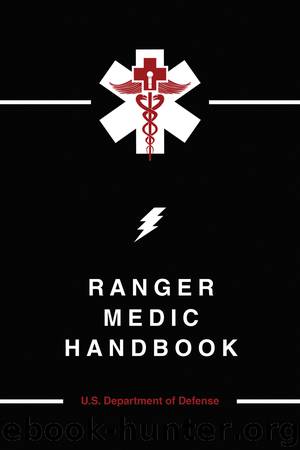Ranger Medic Handbook by Defense

Author:Defense
Language: eng
Format: epub
Publisher: Skyhorse Publishing
Published: 2014-09-16T16:00:00+00:00
2. ACETYLSALICYLIC ACID (ASPIRIN)
Class: CNS agent – NSAID; salicylate; anti-inflammatory, analgesic, antipyretic
Action: Inhibits prostaglandin synthesis involved in the production of inflammation, pain, and fever; enhances antigen removal and reduces spread of inflammation; peripheral analgesic action with limited CNS action in the hypothalamus; antipyretic by indirect centrally mediated peripheral vasodilation and sweating; powerfully inhibits platelet aggregation and ability of blood to clot; high levels can impair hepatic synthesis of blood coagulation factors VII, IX, and X, possibly by inhibiting action of vitamin K
Dose: 325-650 mg PO/PR q4-6h (max: 4 g/d); MI prophylaxis PO 80-325 mg/d (chewable or coated)
Indications: For mild to moderate pain management, fever reduction, and to decrease inflammation; also used for acute rheumatic fever, Systemic Lupus, rheumatoid arthritis, osteoarthritis, bursitis, calcific tendonitis, to reduce recurrence of TIA and risk of stroke, as prophylaxis and to prevent recurrence of MI
Contraindications: Salicylate and NSAID hypersensitivity; patients with "aspirin triad" (aspirin sensitivity, nasal polyps, asthma); chronic rhinitis or urticaria; GI ulcer, bleeding; hypoprothrombinemia, vitamin K deficiency, hemophilia, bleeding disorders; CHF; pregnancy category D; do NOT use in children or teenagers with viral illnesses due to link with Reye's syndrome
Adverse Effects: Rash, urticaria, easy bruising, petechiae, bronchospasm, laryngeal edema; confusion, dizziness, drowsiness; tinnitus, hearing loss; nausea, vomiting, diarrhea, anorexia, heartburn, stomach pain, GI bleeding, ulceration; thrombocytopenia, hemolytic anemia, prolonged bleeding time
Interactions: Aminosalicylic acid and carbonic anhydrase inhibitors increase risk of toxicity; ammonium chloride, acidifying agents decrease renal elimination and increase toxicity; oral hypoglycemic agents increase hypoglycemic activity; corticosteroids increase ulcer potential; methotrexate toxicity is increased; anticoagulants and herbals (feverfew, garlic, ginger, ginkgo) increase bleeding potential
Download
This site does not store any files on its server. We only index and link to content provided by other sites. Please contact the content providers to delete copyright contents if any and email us, we'll remove relevant links or contents immediately.
Periodization Training for Sports by Tudor Bompa(8209)
The Body: A Guide for Occupants by Bill Bryson(5026)
The MacArthur Bible Commentary by John MacArthur(4781)
The Sports Rules Book by Human Kinetics(4338)
What It Really Takes to Get Into Ivy League and Other Highly Selective Colleges by Hughes Chuck(3715)
Marijuana Grower's Handbook by Ed Rosenthal(3640)
The Sprouting Book by Ann Wigmore(3561)
The Martian by Andy Weir(3352)
Salt, Fat, Acid, Heat: Mastering the Elements of Good Cooking by Nosrat Samin(3119)
The Bread Bible by Rose Levy Beranbaum(3035)
Harry Potter 4 - Harry Potter and The Goblet of Fire by J.K.Rowling(3030)
Sapiens and Homo Deus by Yuval Noah Harari(3025)
The Marketing Plan Handbook: Develop Big-Picture Marketing Plans for Pennies on the Dollar by Robert W. Bly(3004)
Classic by Mary Berry(2976)
Martha Stewart's Baking Handbook by Martha Stewart(2824)
Screenplay: The Foundations of Screenwriting by Syd Field(2598)
The Plant Paradox by Dr. Steven R. Gundry M.D(2579)
50 Economics Classics by Tom Butler-Bowdon(2544)
The Cambridge Grammar Of The English Language by Rodney Huddleston Geoffrey K. Pullum(2400)
